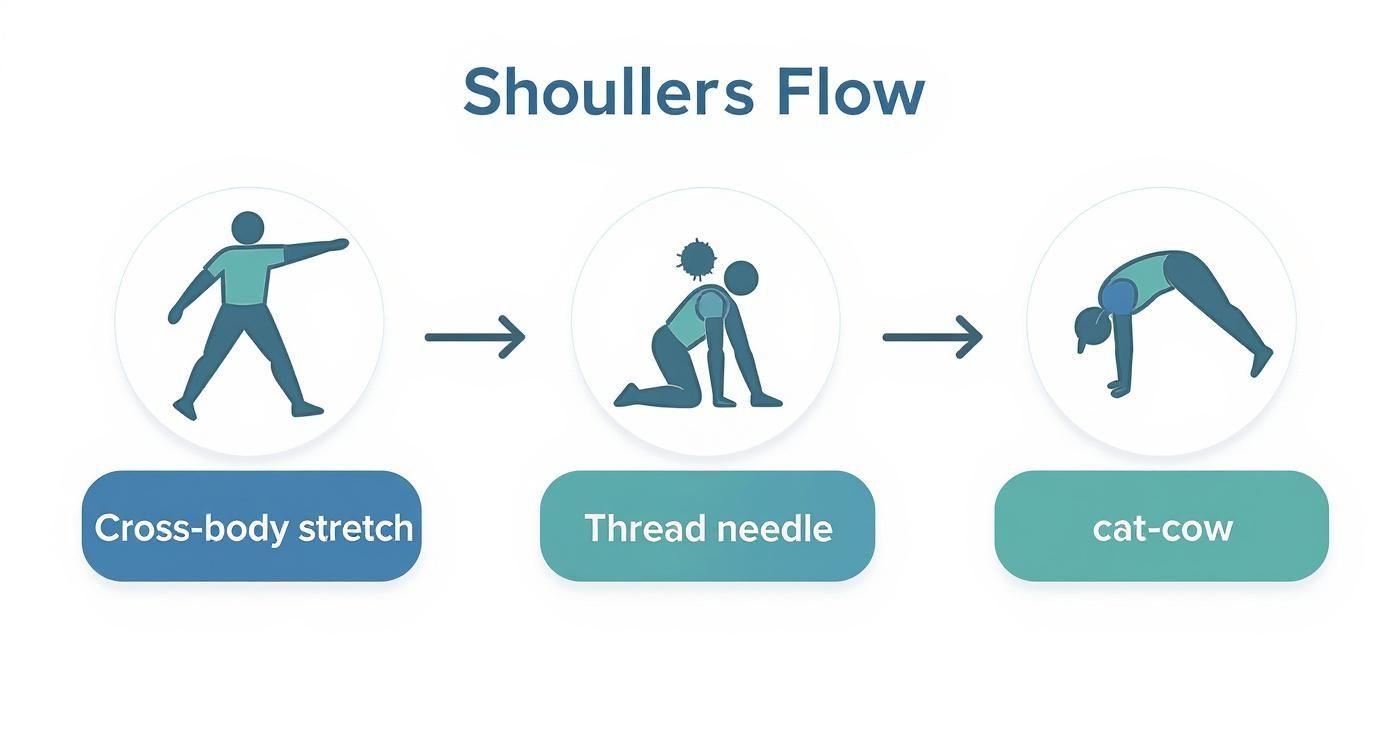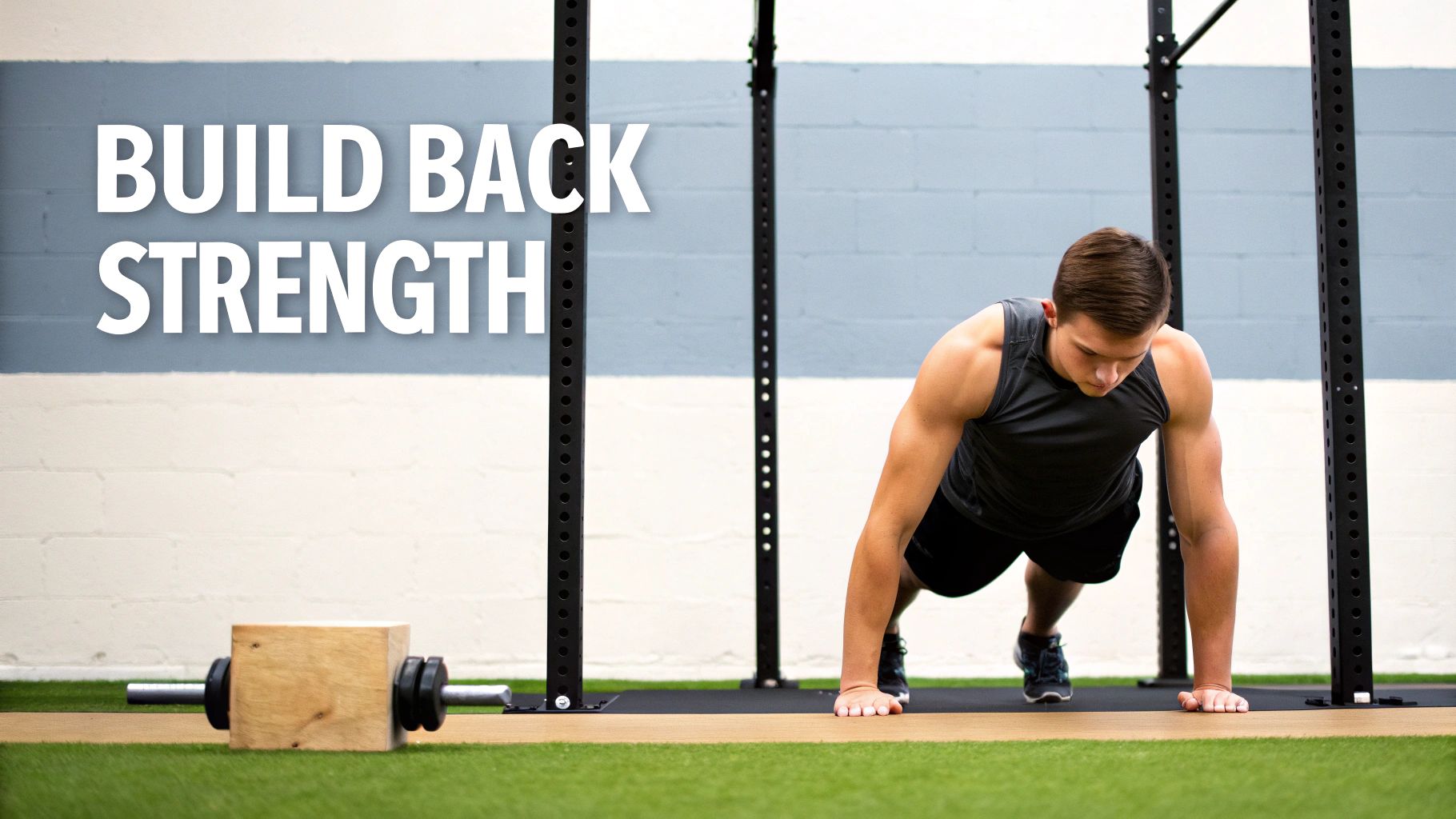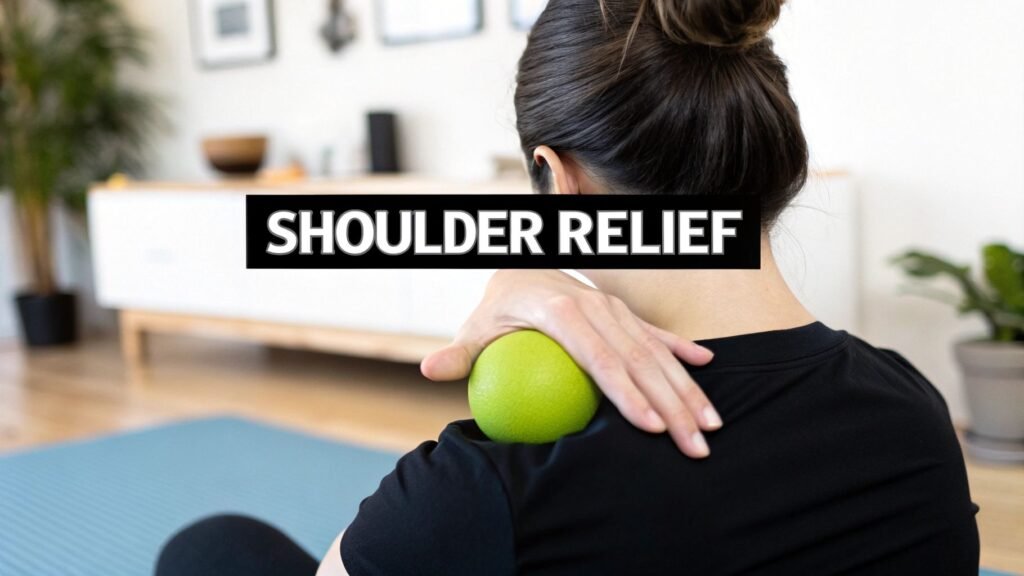To get rid of that nagging ache in your shoulder blade, the best approach is a three-pronged one: targeted stretches, self-massage with a tool like a tennis ball, and an immediate check on your posture. These are straightforward, powerful actions you can take right now to ease muscle tension and tackle the most common roots of the pain.
Pinpointing the Cause of Your Shoulder Blade Pain

Before you can find real, lasting relief, you have to play detective for a minute. Figuring out why your shoulder blade is screaming at you is the most important step.
Is it that dull, persistent ache that sets in after a long day hunched over your laptop? Or is it a sharp, sudden twinge that showed up after a weekend of heavy yard work? Each of these scenarios points to a different root cause, and that changes how you should approach it.
This discomfort isn't just a minor annoyance; it's a clear signal from your body that something is off-balance. In most cases, the culprit is simple muscle strain, particularly in the rhomboid and trapezius muscles that work to pull your shoulder blades together. But sometimes, the pain is a bit more complex, referred from another area like a pinched nerve in your neck or, less commonly, an issue with an internal organ.
Differentiating Between Common Culprits
The source of the pain really dictates the best plan of attack. For example, the strategies you'd use for pain caused by poor posture are completely different from those for a sudden injury.
Let's break down some of the most frequent offenders:
- Muscle Strain and Overuse: This is the big one. It often comes from repetitive motions, lifting something too heavy, or even just sleeping in a weird position. The pain usually feels like a deep, stubborn ache or tightness.
- Poor Posture: This is the classic "desk jockey syndrome." When you slouch, the muscles between your shoulder blades are constantly overstretched and weakened, while your chest muscles become tight. This creates a painful imbalance that's incredibly common.
- Herniated Disc: An issue with a disc in your cervical (neck) or thoracic (upper back) spine can put pressure on a nerve, sending a sharp, radiating pain right toward your scapula.
- Referred Pain: Sometimes, the problem isn't in your back at all. Conditions affecting organs like the gallbladder or even the heart can sometimes manifest as pain around the right shoulder blade.
It’s worth noting just how widespread this issue is. Studies show that the global prevalence of shoulder pain can range from 6.9% to 26% at any given moment. That's a huge number of people dealing with the same kind of discomfort you are.
Common Sources of Shoulder Blade Discomfort
To help you get a clearer picture, I've put together a quick reference table. Think of it as a starting point to help you connect your symptoms to a potential cause and a simple first step you can take.
| Potential Cause | What It Feels Like | First Self-Care Step |
|---|---|---|
| Muscle Strain | A dull, deep ache or tightness that worsens with movement. | Gentle stretching and applying a warm compress. |
| Poor Posture | A persistent, nagging ache that feels better when you lie down. | Consciously sit/stand up straight; take frequent breaks. |
| Nerve Impingement | Sharp, shooting, or burning pain; may include numbness/tingling. | Avoid positions that trigger it; gentle neck stretches. |
| Referred Pain | A constant ache unrelated to movement, possibly with other symptoms. | Monitor symptoms and consider professional advice if it persists. |
This table isn't for self-diagnosis, but it can guide your initial response. If simple self-care isn't making a dent, it's a sign that something more is going on.
When to Seek Professional Guidance
While self-care is fantastic for most muscle-related aches, certain symptoms are red flags that shouldn't be ignored. If your pain is severe, comes with numbness or weakness in your arm, or simply doesn't get better after a few days of gentle care, it's time to see a professional.
To get to the bottom of it, a physical therapist might use a goniometer for measuring shoulder mobility to get a precise reading of your range of motion. Properly understanding the source of back pain is crucial for effective treatment, whether it’s in your upper or lower back.
The Best Stretches for Quick Relief
When that nagging ache or sharp pain flares up between your shoulder blades, the right kind of movement can bring surprisingly fast relief. The idea is to gently release the tension that has built up in those overworked muscles, like the rhomboids and trapezius, which are almost always the source of the problem.
Stretching effectively isn't about muscling through a position. It's about combining mindful, controlled movements with deep, steady breathing. As you hold a stretch and breathe, you’re helping to deliver fresh oxygen to those tight muscle fibers, coaxing them to relax and lengthen. This is how you can ease that shoulder blade pain without accidentally making it worse.
Key Stretches for Releasing Your Shoulder Blades
Forget generic, all-purpose movements. What you need are stretches that specifically zero in on the muscles surrounding your scapula. The key is to perform them slowly and with real intention.
Think of your muscles like a cold rubber band. If you yank on it too quickly, it might snap. But with gentle, sustained pressure, it warms up and becomes more flexible. That's exactly the approach we're taking here.
-
Cross-Body Arm Stretch: This is a classic for a reason. It does an incredible job of getting into the posterior deltoid and the muscles that wrap around your shoulder blade. Just bring one arm across your chest and use your other arm to gently pull it closer until you feel a comfortable stretch. Hold it for 20-30 seconds while breathing deeply, then switch.
-
Doorway Stretch: So much upper back pain actually starts at the front. This stretch opens up your chest muscles (your pecs), which get incredibly tight from slouching over a computer and pull your shoulders forward. Stand in a doorway, place your forearms on the frame with your elbows just below shoulder height, and take a gentle step forward. You'll feel it immediately.
A common mistake I see is people bouncing while they stretch. This actually backfires. It can activate a muscle's protective reflex, causing it to tighten up even more. You want to hold each stretch in a static, steady position. That sends a signal to your body that it’s safe to let go of the tension.
Dynamic Movements to Restore Mobility
Static holds are fantastic, but don't stop there. Adding some gentle, flowing movements into the mix can do wonders for your pain. These dynamic stretches are great for boosting circulation and warming up the muscles, which makes them less likely to get stiff in the first place.
A perfect example is the "Thread the Needle" stretch. It gives you a gentle spinal twist combined with a deep stretch for your upper back and shoulders.
- Get on your hands and knees, like a tabletop.
- Reach your right arm straight up toward the ceiling, opening your chest to the right side.
- As you exhale, sweep or "thread" your right arm underneath your left, lowering your right shoulder and ear to the floor.
- Just rest here for a few deep breaths. You should feel a great stretch across your right shoulder blade.
- Slowly come back up and do the same thing on the other side.
This isn't just a rhomboid stretch; it also helps mobilize your thoracic spine—the part of your back that gets especially rigid from sitting at a desk all day.
Don't Forget: Form and Breathing Are Everything
Listen, the power of any stretch is all in the details. You should only ever move into a stretch until you feel a gentle pull, never a sharp pain. Let your breath be your guide. Inhaling helps you prepare, and exhaling is your cue to relax and sink a little deeper into the movement.
Pay close attention to your alignment. When you’re doing the cross-body stretch, for example, make sure you aren't hiking your shoulder up toward your ear. Keeping it down and relaxed is what really isolates the stretch where you need it most. These small tweaks are what transform a simple movement into a truly powerful tool for getting rid of shoulder blade pain.
Self-Massage Techniques for Deep Muscle Release
Stretching is fantastic for surface-level relief, but sometimes the pain between your shoulder blades feels deeper—like a stubborn, buried knot that just won't let go. That’s when you need to bring in the big guns: self-massage.
This technique, also known as self-myofascial release, lets you apply direct, sustained pressure to those tight trigger points. It coaxes the muscle to release in a way that stretching alone often can't quite manage.
You don't need a lot of fancy gear to get started, either. A simple tennis ball, a firmer lacrosse ball, or a foam roller will do the trick perfectly. The goal is to use a tool that lets you control the intensity and zero in on the exact source of your discomfort.
Using a Tennis Ball Against a Wall
Starting against a wall is your best bet because it gives you the most control. You can easily dial the pressure up or down just by stepping your feet closer to or further from the wall. This is a brilliant way to hit the muscles between your spine and shoulder blade, especially those pesky rhomboids.
First, wedge the tennis ball between your upper back and a solid wall. Make sure to place it on the tight, fleshy part of the muscle, not directly on your spine.
Gently lean into the ball with your knees slightly bent. From there, slowly move your body up, down, and side-to-side, letting the ball roll over the sore spots.
When you find a spot that’s particularly tender—that's a trigger point—just pause there. Hold that gentle, steady pressure for 20-30 seconds. Breathe deeply, and wait for that feeling of the muscle starting to soften and let go.
The sweet spot you're looking for is "therapeutic discomfort," not sharp, wincing pain. If you find yourself holding your breath, you’re pushing too hard. Ease up a bit. An effective release only happens when your nervous system feels safe enough to relax its grip.
To complement this deep-tissue work, you'll want to incorporate some specific movements. This short routine shows a few great ones to pair with your self-massage.

Combining these stretches with targeted pressure from a massage ball creates a powerful one-two punch against those deep, stubborn muscle knots.
Advancing to the Floor and Foam Roller
Once you get the hang of the wall technique, you can graduate to the floor for a more intense session. Lying on your back with a massage ball or foam roller underneath uses your full body weight, delivering much deeper pressure. A foam roller is especially good for tackling broader areas of tightness across the upper back.
Here’s how to approach it:
-
With a Foam Roller: Lie down with the roller placed horizontally under your shoulder blades. Bend your knees and plant your feet on the floor to keep yourself stable. Now, cross your arms over your chest (give yourself a hug!) to pull your shoulder blades apart and expose the muscles underneath. Use your legs to slowly roll your body up and down, from the base of your neck to about the middle of your back.
-
With a Massage Ball: The technique is the same as against the wall, but the pressure will be significantly more intense. Remember to move slowly and deliberately. You're on a mission to hunt down those specific trigger points and give them time to release.
These hands-on methods give you immediate feedback and total control, putting you in the driver's seat when it comes to managing flare-ups at home.
And if you're curious about other manual therapies that work well with self-massage, it's worth understanding how cupping therapy works as another powerful tool for releasing muscle tension. By consistently using these self-care tools, you can truly take control of your own shoulder blade pain.
Strengthening Your Back to Prevent Future Pain

While stretches and self-massage are fantastic for immediate relief, they're really just playing defense. To get lasting freedom from that nagging shoulder blade pain, you have to go on the offense. That means building a stronger, more resilient back.
Think of it this way: we're shifting the focus from just chasing the pain to fixing the root cause—muscles that are too weak to hold up against the daily grind of sitting, typing, and driving.
Strengthening the muscles around your shoulder blades—especially the rhomboids and mid-trapezius—is like building a natural support system. A strong back holds your shoulders in a better, healthier alignment, which dramatically cuts down on the strain that creates all those chronic aches and knots in the first place.
Foundational Exercises for Shoulder Stability
You don't need to live in a gym to build this kind of functional strength. In fact, a few simple, controlled movements done with good form are way more effective than trying to lift heavy weights with sloppy technique. Our goal here is smart muscle activation, not brute force.
Here are a couple of my go-to exercises to get you started:
- Band Pull-Aparts: This is the absolute gold standard for hitting those key postural muscles between the shoulder blades. Grab a light resistance band, hold it with both hands, and extend your arms straight out in front of you at shoulder height. Now, keeping your arms straight, pull the band apart by really squeezing your shoulder blades together. Imagine you're trying to pinch a pencil between them.
- Seated Rows: Anchor a resistance band to a doorknob or sturdy post. Sit up tall with your legs out in front. Grab the band and pull your elbows straight back, once again focusing on that powerful squeeze between your shoulder blades. The biggest mistake I see is people shrugging their shoulders up to their ears—avoid that at all costs.
With both of these, the return journey is just as important. Don't just let the band snap back; control the movement slowly. That's the eccentric phase, and it's crucial for building real strength. I recommend aiming for 2-3 sets of 12-15 repetitions, always prioritizing perfect form over the number of reps.
Building this muscular scaffolding is critical because, frankly, shoulder issues can take a long time to resolve. Research shows that only about 50% of patients with new shoulder problems report a complete recovery after six months. This really drives home how important preventive strength work is for long-term health.
The Importance of Gradual Progression
As you get stronger, your body adapts. That's your cue to gently dial things up. Progress doesn't have to mean grabbing a heavier weight. It could be as simple as adding a few more reps, doing another set, or moving to a slightly thicker resistance band.
The key is to listen to your body. You should feel the muscles working, but never sharp pain. Remember, consistency beats intensity every single time. A few focused sessions each week will build a strong foundation that serves as your best defense against future pain.
If you're dealing with stubborn, ongoing issues, exploring alternative therapies for chronic pain can be a great way to complement your strengthening routine.
Lifestyle Adjustments for Long-Term Shoulder Health
While stretches and self-massage give you that much-needed immediate relief, it's your daily habits that truly build lasting shoulder resilience. It’s far better to prevent that nagging ache from starting than to constantly be putting out fires. A few key adjustments to your daily life can create an environment where your shoulders can finally thrive, not just survive.
These aren't massive, life-altering changes. In my experience, the most powerful shifts are the subtle ones—the small tweaks to your routine that dramatically reduce the cumulative strain on your upper back over time.
Optimize Your Workspace Ergonomics
If you work at a desk, your workstation is ground zero for shoulder blade pain. A poorly configured setup forces your muscles into a constant state of low-grade tension, which is a recipe for discomfort. The entire goal here is to create a neutral, supported posture that your body can relax into.
Here’s where to focus your attention first:
- Monitor Height: Your screen needs to be directly in front of you. The top of the monitor should be at or just slightly below your eye level. This one change stops you from craning your neck down all day, a major source of strain for your neck and upper back.
- Chair Support: A good chair supports the natural curve of your lower back. Your feet should be flat on the floor, with your knees bent at roughly a 90-degree angle. If your chair’s lumbar support is lacking, a small rolled-up towel or a dedicated lumbar pillow can make a huge difference.
- Keyboard and Mouse Placement: You want your keyboard and mouse close enough that your elbows stay tucked comfortably by your sides. If you’re constantly reaching forward, you’re forcing your shoulder blades to pull apart and round your back—a primary culprit behind that deep, burning pain.
The secret to lasting health lies in small, consistent actions. Try setting a reminder to take a two-minute "posture break" every 30 minutes. Just stand up, roll your shoulders back and down, and gently squeeze your shoulder blades together. It’s a simple way to reset your posture and remind those overworked muscles where they're supposed to be.
Mindful Movement in Daily Life
What you do away from your desk matters just as much. Think about how you carry things. Do you always sling a heavy bag over the same shoulder? That's a classic way to create a significant muscular imbalance that leads directly to pain.
Even the way you sleep plays a role. Sleeping on your stomach forces you to keep your head turned sharply to one side for hours, which can easily strain the muscles in your neck and shoulders. Sleeping on your back with a pillow under your knees, or on your side with one between them, is much better for maintaining healthy spinal alignment.
Finally, you can't ignore the mental side of things. Chronic stress is a huge contributor to muscle tension, especially around the shoulder blades. It’s worth exploring strategies to prevent burnout and break the stress cycle, because a stressed mind often leads to a tense body. Adopting these habits is about being proactive—not just treating the pain you have now, but preventing it from ever coming back.
Got Questions About Shoulder Blade Pain? Let's Clear Things Up.
When you're trying to figure out how to get rid of nagging shoulder blade pain, a lot of questions pop up. Knowing what to do—and when to see a professional—is the first step toward getting real relief. Let's tackle some of the most common concerns I hear from clients.
You're probably wondering how long this is going to last. If your pain is from a simple muscle strain—maybe you overdid it at the gym or spent too long hunched over a laptop—you can often feel a world of difference in just a few days to a week. The key is being consistent with gentle stretches, self-massage, and giving the area a break.
But if the root cause is something more complex, like a pinched nerve, the timeline will naturally be longer and require a more specific treatment plan.
Heat or Ice? The Age-Old Question
This is one of the most frequent questions I get, and for good reason. The answer really depends on what's causing your pain. Here’s a simple way to remember it: ice for injuries, heat for muscle tension.
- Reach for ice if the pain is new and sharp, especially if it’s from a sudden injury or you notice any swelling. Apply it within the first 24-48 hours. The cold helps calm inflammation and provides a nice numbing effect.
- Switch to heat for that deep, chronic ache, stiffness, or those stubborn knots that won't let go. A heating pad or a warm shower increases blood flow, which is fantastic for relaxing tight muscles. Most posture-related shoulder blade pain fits this description.
A quick safety note: Always use a towel as a barrier between your skin and the pack, and keep it on for no more than 15-20 minutes at a time.
How Do I Know If It's Something Serious?
Most of the time, shoulder blade pain is muscular. But it’s smart to know the signs that point to something more. You should absolutely see a doctor if the pain is severe, constant, and doesn't get better with rest or changing positions.
The real tell-tale sign that you're dealing with more than just a muscle knot is the presence of other symptoms. If your shoulder pain comes with chest pain, trouble breathing, a fever, or sudden weight loss, don't wait. It’s time to see a doctor right away to rule out anything serious.
Another red flag is pain that shoots down your arm, or if you feel any significant weakness, numbness, or tingling. That could signal that a nerve is involved. Don't just hope these symptoms will go away on their own. An accurate diagnosis is everything—it’s the only way to get a safe, effective treatment plan that truly resolves the problem.
At Eric Tsai Acupuncture and Herbs, we dig deep to find the root cause of your discomfort. From there, we build a personalized plan to bring your body back into balance and provide relief that actually lasts. Learn more about our approach to pain management at drerictsai.com.

